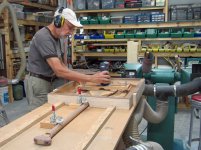"Camber" and "dihedral" are usually (but perhaps incorrectly) used as synonyms when talking about paddle blades. I assume by camber you are referring to the thinning out—or the sloping of—each facet of the blade from a central "spine" to the edge of the blade.
Highly cambered blades, like some animal tail paddles, have a defined ridge down the middle of the blade, sometimes all the way from the throat to the tip of the blade. No camber blades are essentially spineless and flat-faced.
My recollection, which could be wrong, is that your paddles have minimal camber. But that's sort of subjective. So, let me ask specifically:
- Is your spine a defined ridge or more of a gentle arch? How far down the blade does it extend?
- Is your camber on each blade facet—i.e., on each side of the spine—flat, subtly concave or subtly convex?
- Are these answers about spine and camber different for your different paddle models, such as the river model, freestyle model and shallow water model?








